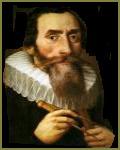

His own mother was tried for witchcraft during 1615-16, and her defense at trial was conducted by none other than her son, resulting in her being set free, but not until 1620. There are few examples of human resilience that rival Kepler’s life. In 1584, Kepler entered the Protestant seminary at Adelberg, and in 1589 he began his university education at the Protestant university of Tübingen where he studied theology and passed the M.A. examination in 1591, and continued his studies as a graduate student. His mathematics teacher was Michael Maestlin, one of the earliest astronomers to subscribe to the heliocentric theory of Copernicus.
He taught only the Ptolemaic system, but in private time acquainted his students with the technical details of the Copernican system. Kepler accepted an appointment as professor of mathematics at the Protestant seminary in Graz, Styria in 1594 where he was also appointed district mathematician and calendar maker, and he taught arithmetic, geometry, Virgil and rhetoric. In 1597, Kepler married Barbara Müller and published his first important work, ‘The Cosmographic Mystery,’ about the distances of the planets from the sun.
He stayed in Graz until 1600, when all Protestants were forced to convert to Catholicism or leave the province. During the period in Graz, the Keplers had three children. In 1600, Kepler was invited to Prague to become Tycho Brahe’s assistant and calculate new orbits for the planets, and upon Tycho’s death was named his successor as Imperial Mathematician, the most prestigious appointment in mathematics in Europe. He occupied this post until 1612 when Emperor Rudolph II was deposed. Kepler published a number of important books in Prague: In 1604, ‘Astronomia pars Optica,’ containing modern explanations of the eye, earned him the title of “founder of modern optics.” De Stella Nova on the new star appeared in 1604, and then ‘Astronomia Nova’ which contained his first two laws.
In 1610, Kepler heard and read about Galileo’s discoveries with the spyglass and composed a long letter of support. Later that year he published his observations in ‘Narratio de Observatis Quatuor Jovis Satellitibus.’ Kepler’s wife Barbara died in 1612 and Kepler accepted the position of mathematician in the city of Linz, a position he occupied until 1626. In Linz, Kepler married Susanna Reuttinger. The couple had six children, of whom three died very early.
In Linz, Kepler published a work on chronology and the year of Jesus’s birth in both German and Latin: ‘De Vero Anno quo Aeternus Dei Filius Humanam Naturam in Utero Benedictae Virginis Mariae Assumpsit,’ a work in which Kepler demonstrated that the Christian calendar was in error by five years. This was followed by ‘Epitome Astronomiae Copernicanae’ between 1617 and 1621, an introduction to heliocentric astronomy, and in 1619 ‘Harmonice Mundi,’ where he derives the heliocentric distances of the planets and their periods from considerations of musical harmony. The Third Law published is his ‘Harmonices Mundi’: The squares of the periodic times are to each other as the cubes of the mean distances. It was this law, not an apple, that led Newton to establish the laws of celestial mechanics. Kepler also published numerous smaller works.
1618 marked the beginning of the Thirty Years’ War, making his position in Linz precarious even though as a court official he was exempted from a decree that banished all Protestants. Kepler published the seven-volume ‘Epitome Astronomiae’ in 1621, and was having his ‘Tabulae Rudolphinae’ printed when Linz was besieged as peasant rebellion broke out and the printer’s house, shop and much of his new work was destroyed. Soldiers were garrisoned in Kepler’s house. He and his family left Linz in 1626. The ‘Tabulae Rudolphinae’ were published in 1627.
Kepler’s family was Lutheran and he adhered to the Augsburg Confession. However, he did not adhere to the Lutheran position on “the real presence” and refused to sign the Formula of Concord. Because of his refusal, he was excluded from the sacrament in the Lutheran church. This, and his refusal to convert to Catholicism, left him alienated by both the Lutherans and the Catholics. Kepler now had no position and no salary. He tried to obtain appointments from various courts and returned to Prague in an effort to collect salary that was owed him from his years as Imperial Mathematician from the imperial treasury.
He died in Regensburg in 1630 while on a journey to collect a debt. Kepler was constantly in a state of money worries and forced relocation. Yet through it all, he managed to be first to explain that the tides are caused by the Moon, first to suggest that the Sun rotates about its axis, first to derive the now universally accepted birth year of Christ, first to coin the word “satellite,” first to explain the principles of how a telescope works, first to investigate the formation of pictures with a pin-hole camera, first to explain the process of vision by refraction within the eye, first to formulate eyeglass design for near-sightedness and far-sightedness, first to explain the use of both eyes for depth perception, and first to correctly explain planetary motion.